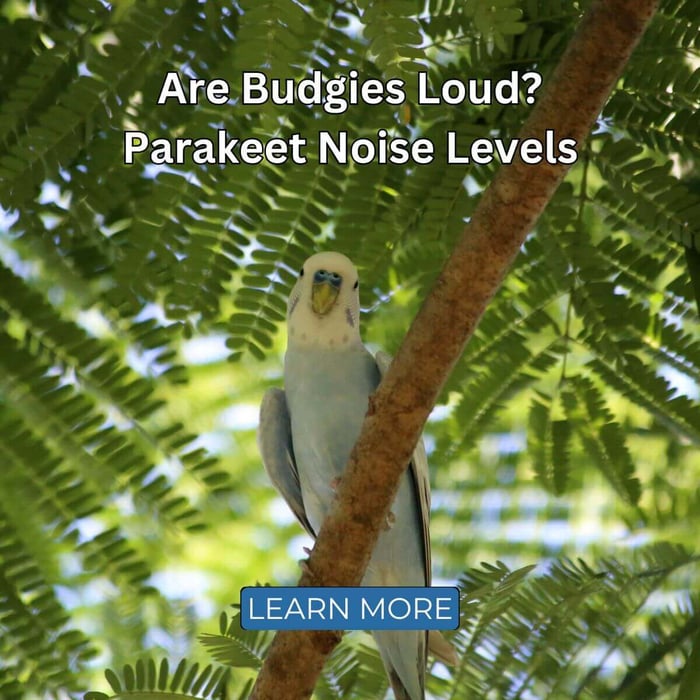How to Tell if Your Budgie is Male or Female - Parakeet Gender
If you're wondering whether your parakeet or budgie is male or female, you're in luck. Assuming it's a budgie, and you know how to tell the gender of a parakeet, you should, in most cases, be able to figure it out. Budgies' appearances contain visual indicators of their gender: they are sexually dimorphic.
Keep reading for everything you need to know about how to tell if a budgie is male or female!
How to Tell if a Budgie is Male of Female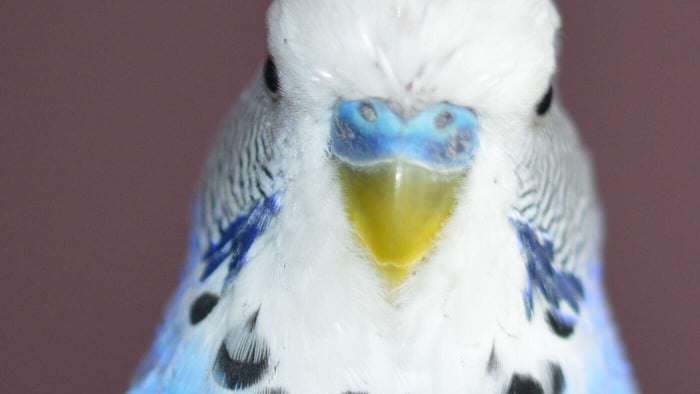
So, is your budgie a male or a female? Now, let's start off by mentioning that the only way to absolutely be 100% sure of the sex of a budgie is a DNA test. Differences can be pretty subtle, and in some cases, it's easy to misinterpret them. In other cases, the budgie itself just doesn't seem to care about the rules and simply closely resembles the other sex!
The most reliable way to visually sex a budgie, one that you can use yourself, is looking at the bird's cere. The cere is the nose area above the beak that contains the nostrils. It is a different colour than the beak itself, and that colour is a clue to your budgie's gender.
That was the good news. The bad news is that there's not just one colour for males and one colour for females. It varies with age, colour mutation and broodiness.
To establish the gender of a budgie, first, you must know whether you're dealing with a baby budgie or an adult one. Then, use the guidelines below to establish whether it's a boy or a girl.
Young Budgies
- Young male budgies will have a light purple or pinkish cere.
- Young female budgies will have a light blue-whitish cere. Sometimes, there are white-ish rings around the nostrils.
Warning: the differences here can be really quite subtle! I've found that generally, young males will be the ones with a slightly darker-coloured cere, as the pink or purple tinge darkens the colour a bit compared to females' blue or white-ish. Still, it's much easier to figure out the gender of an adult budgie than a juvenile one.
Adult Budgies: Regular Colour Mutations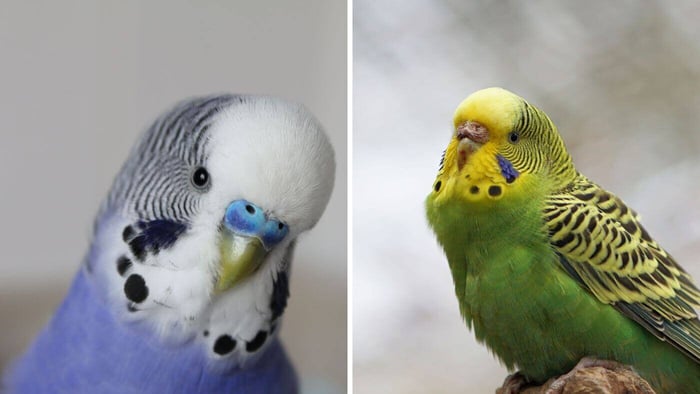
- An adult male budgie will have a blue cere. If it's ready to breed, the cere will really be bright blue; if it's not, then it will be a more subtle light blue.
- An adult female budgie will have a flaky brown cere if she is broody. If she's not, then her cere will lean more towards tan or even almost white-ish. It might also feature a hint of blue, so that can be confusing, but it will never be dark blue.
Adult Budgies: Bied, Lutino and Albino
If your budgie is albino (white with red eyes), lutino (yellow with red eyes) or recessive pied (with spots all over the body that can change with age), you'll have to pay close attention. Males of these colour varieties won't follow the blue cere rule.
- Males with these colour mutations will feature a pink or purple cere. Quite similar to the colour of a young male budgie's cere, it just never changes to blue.
- Females with these colour mutations follow the normal female cere rules: flaky and brown when broody, tan or white when not.
Rule of thumb: if the cere has any red mixed in (leading to purple or pink colouration), that indicates male, specifically a juvenile male or one of the exception colours. Females will never normally really show these colours on the cere.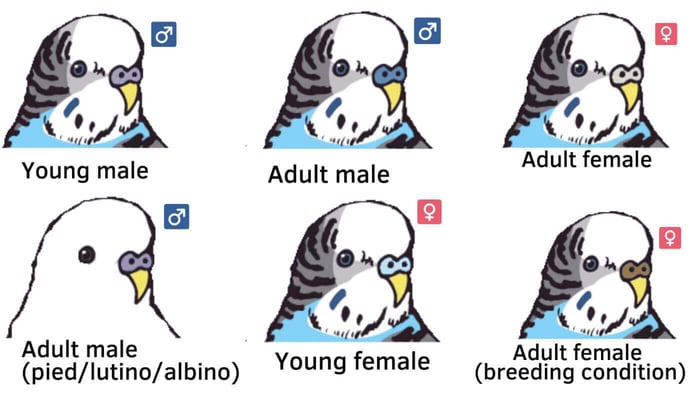
Other Indications to Show If a Budgie is Male or Female
The cere colour is a relatively clear way to figure out a budgie's gender in most cases. Sometimes, it's just too difficult to figure out, or a bird's cere simply doesn't follow the rules. There are some behavioural indications of a budgie's sex as well, which you might find helpful.
These are not definitive at all since some female budgies are just manly and the other way around, but they can help make you feel more confident in your ruling.
- If a budgie only squawks and never really sings or chatters, it's probably a female. The males are the singers.
- Females are known to be a bit more assertive – maybe we could call it 'moody'.
- Males are flirty. They display seductive head-bobbing dances and may mount other budgies (even fellow boys) to attempt to mate.
- Females can be more destructive as they chew things apart, looking to create nesting material.
Parakeet Gender Chart
| Cere colour: | Gender: |
| Purple | Young or pied male |
| Dark blue | Adult male |
| Light blue | Young female |
| Tan or brown, flaky | Adult female |
Does Gender Matter?
When choosing your budgie or other parakeet, does it matter whether you go for a male or a female? It depends, of course, on your preferences.
Someone who intends to breed their birds obviously has to be very certain of the sex of their birds before buying, which is where DNA tests come in. There are also some other things to keep in mind:
Health Issues
Even if you're just looking for a companion parakeet, gender can still matter to some degree. It's especially important to know if you have a female budgie, as there are some sex-specific issues that you can run into.
Female budgies are likely to become broody on a yearly basis, and they may lay eggs. This is quite a strain on their little bodies. A laying female will need some extra nutrients, like additional protein and plenty of calcium.
Unfortunately, things don't always go as they should. Egg binding, when an egg gets stuck in your budgie's body, is an example of a female-specific medical emergency.
Did you know? Although female budgies are more prone to sex-specific problems, you can run into issues with males as well. Unfortunately, testicular cancer is not uncommon in budgies. This disease can be indicated by a change in cere colour from blue to brown.
Behaviour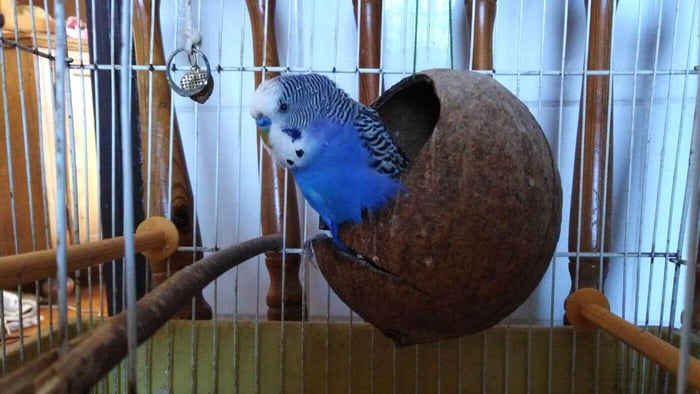
As you've probably been able to conclude from the above sexing guides, male and female parakeets do display different behaviours.
Keep the following in mind when choosing whether to go for a boy or girl, though don't forget that sometimes females do behave 'manly' and vice versa.
- Generally, male parakeets are more vocal than females. They're the ones who have to woo the opposite sex with their songs, so they sing more elaborate tunes than most females. The females tend to just stick to flock calls and simple squawks. They generally won't learn to talk as well as males, but they are louder.
- Females can be a bit bossier and more difficult to tame. Your female might become particularly assertive when she's broody.
- Females might shred materials and come up with makeshift nesting spots in lieu of a nest box. They can become territorial about this space.
Reading the above, it might seem like males make better pets than females. Really, though, generally, it doesn't matter that much. The differences aren't that pronounced, and one advantage of female parakeets is that they do bond very strongly with their owner in a lot of cases. Just get the bird that you connect with.
If you have any more questions about how to tell the gender of a parakeet or if you want to share whether your budgie turned out to be a boy or a girl, don't hesitate to leave a comment below!
FAQs
Are male budgies bigger than females?
Not really, both genders tend to weigh 30-40 grams. Some say males can be more robust, but the difference isn't pronounced enough to help much.
Can two male budgies live together?
Sure! Two male budgies will usually bond to each other just fine. Don't be concerned if you see them trying to mount each other – aside from squabbles about who is supposed to be the "boy" in the relationship, it's not an issue.
Can two female budgies live together?
Absolutely. They may squabble over potential nesting spaces when hormonal, but as long as there's enough space, they'll get along great.
Are female budgies more aggressive?
Generally, yes, they can be more territorial about nesting places. However, that doesn't mean you should avoid them. You can still tame and bond with a female budgie just fine.


